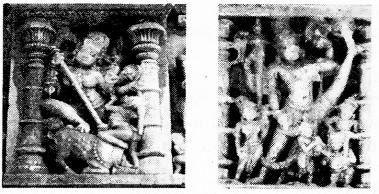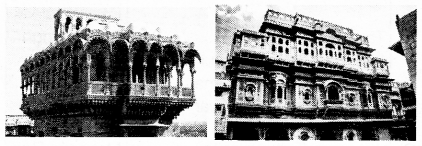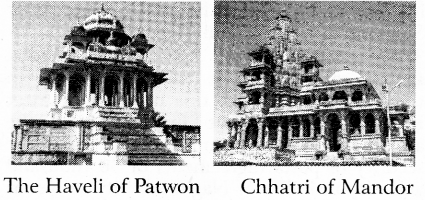RBSE Solutions for Class 7 Social Science Chapter 21 Art and Architecture are part of RBSE Solutions for Class 7 Social Science. Here we have given Rajasthan Board RBSE Class 7 Social Science Chapter 21 Art and Architecture.
| Board | RBSE |
| Textbook | SIERT, Rajasthan |
| Class | Class 7 |
| Subject | Social Science |
| Chapter | Chapter 21 |
| Chapter Name | Art and Architecture |
| Number of Questions Solved | 43 |
| Category | RBSE Solutions |
Rajasthan Board RBSE Class 7 Social Science Chapter 21 Art and Architecture
Exercise From Textbook
Multiple Choice Questions
Write the correct answer of questions first and second in the bracket.
Question 1.
The havelis of Patavas are :
(a) In Jaisalmer
(b) In Jodhpur
(c) In Jaipur
(d) In Udaipur
Answer:
(a) In Jaisalmer
Question 2.
The Jain temples of Dilwara are in :
(a) In Sirohi
(b) In Jodhpur
(c) In Jaspur
(d) In Udaipur
Answer:
(a) In Sirohi
Question 3.
Match the column A with B :
| Column A | Column B |
| 1. Kumbhalgarh | (a) Jhalawar |
| 2. Ranthambore | (b) Jaisalmer |
| 3. Sonargarh | (c) Sawaimadhopur |
| 4 Gagron | (d) Rajsmand |
Answer:
1. (d)
2. (c)
3. (b)
4. (a).
Question 4.
What is Parkota and Pracheer?
Answer:
Parkota is the strong wall constructed around the fort for its security purpose whereas Pracheer is the surrounding wall of the fort.
Question 5.
What is a fort?
Answer:
Fort is that area or place around which a safety wall Parkota or Pracheer is made.
Question 6.
Who got the fort of Chhitorgarh built?
Answer:
Maurya ruler Chitrangad got the fort of Chittorgarh built.
Question 7.
What is meant by the style of painting?
Answer:
Style of painting means a special method of painting.
Question 8.
What Is the identification of Pothi style of painting?
Answer:
The identification of Pothi style of painting is sharp nose like an eagle protruding ahead, Shin eyes, small chin, rigid fingers, thin waist, etc.
Question 9.
Which are the famous figures of Rajasthani art of sculpturing?
Answer:
Famous figures of Rajasthani art of sculpturing are : Mahesh Idol, Ardhanareshwar, Uma Maheswar, Harihar and Anugraha.
Question 10.
Which are the major temples of Marwar?
Answer:
Major temples of Marwar are :
- Jain temple of Dilwara (Abu-mountain- Sirohi)
- Jain temple of Ranakpur (Pali)
- Temples of Kiraru (Barmer)
- Temples of Osia (Jodhpur)
- Jain temples of Jaisalmer, etc.
Question 11.
What is meant by the Rajasthani art of painting?
Answer:
It is the initial form of art of painting in Rajasthan which has been seen blooming.
Question 12.
Write a description of one of the centres of Jain temples of Rajasthan.
Answer:
Jain temples of Dilwara (Abu-mountain Sirohi) built in 11 to 12th century are the great examples of Solanki art. Abu-mountain in Dilwara has 5 Shwetamber Jain temple and one Digambar Jain temple.
Vimal Sirohi Jain temple was built by the emperor of Chalukys, in Gujarat, Maharaj Bhimdev’s minister and army chief Bimalshah Lurabsingh temple was constructed by king of Chalukya Virdhawal’s minister Vastupal and Tejpal in 1230-31. Other than this, in four temples of Kunthunath’s Digamber Jain temple Bhimshah (Pithar) temple. Parsavnath temple and Mahavir Swami Mandir are also included.
Activities From Textbook
Activity
Question 1.
In Rajasthan there are more forts apart from these, collect Information about them and write. Collect their pictures also. Or, Make a list of the forts of Rajasthan.
Answer:
| Forts | Place | Builder |
| 1. Chittorgarh | Chittor | Chitrangad Maurya |
| 2. Kumbhalgarh | Rajsamand (Border of Mewar and Marwar) | Maharana
Kumbha |
| 3. Ranthambore | Sawai Madhopur | Mahesh Thakur |
| 4. Jalore Durg | Jalore | Dharavarsh and Munj, Parmar rulers |
| 5. Taragarh | Bundi | Rao Birsingh |
| 6. Mehrangarh | Jodhpur | Rao Jodha |
| 7. Sonargarh | Jaisalmer | Rawal Jaisal |
| 8. Gagron Fort | Jhalawar | Parmar (Dod) Rajput |
| 9. Junagarh Fort | Bikaner | Maharaja Rao Singh |
| 10. Amer Fort | Jaipur | Raia Dhaularai |
| 11. Siwana Durg | Siwana (Barmer) | Veernarayan Pawar |
| 12. Dudu ka Durg | Ajmer-Jaipur Route | Shyam Singh |
| 13. Nagore Durg | Nagore | Rathore Sawant Kumar Kaimas |
| 14. Bhatner Durg | Hanumangarh | Raja Bhupat |
| 15. Acchalgarh Durg | Abu | Maharana Kumbha |
| 16. Bayana Durg | Bayana (Bharatpur) | Maharaja Vijaypal |
| 17. Taragarh | Ajmer | Ajaypal |
| 18. Bala Quila | Alwar | Alaghurai |
| 19. Lohagarh Durg | Bharatpur | Maharaja Suraimal |
Activity
Question 1.
Collect pictures of idols built in the temples of Rajasthan or other places and also try to make their drawings.
Answer:
Idols
(1) Mahishasur-Mardini (Osian, Jodhpur)
(2) Trivikram (Nagda-Udaipur)

Activity
Question 1.
With the help of your teacher and elders make a list of the temples around you.
Answer:
My teacher and my uncle told me that temples around us are Barah Temple, Brahma Temple, Baikunthnath Temple, Mahadev Temple, and Rangji Temple etc.
Question 2.
Collect pictures of Havelis and Chhatris from your nearby areas.
Answer:
(1) Salim Singh Haveli
(2) Nathmal Haveli

Havelis
(1) The Haveli of Patwon
(2) Chhatri of 84 Pillars in Bundi The Haveli of Patwon Chhatri of Mandor
(3) Chhatri of Mandor.

Question 3.
Draw some pictures based on the painting style of medieval periods
Answer:
Do yourself with the help your teacher.
Other Important Questions
(A) Multiple-Choice Questions
Question 1.
UNESCO has announced this fort as the world heritage site.
(a) Red Fort Of Agra
(b) Red Fort of Delhi
(bj Both A & B
(d) None of these
Answer:
(a) Red Fort Of Agra
Question 2.
Among the following, below options who has appreciated the grand palaces of Patliputra?
(a) Megasthenese
(b) HieunTsang
(c) Using
(d) Fa-Hien
Answer:
(a) Megasthenese
Question 3.
From the below options given, which is considered as the initial point of Rajasthani painting style?
(a) South-lndian style
(b) North-Eastern Indian style
(c) Western Indian style
(d) None of these
Answer:
(c) Western Indian style
Question 4.
Kings of Chauhan dynasty in Ranthambor ruled for.
(a) 600 years
(b) 600 years
(c) 700 years
(d) 800 years
Answer:
(b) 600 years
Question 5.
Who among these has built almost 32 forts in his area?
(a) Maharana Pratap
(b) Veer Amar Singh
(c) Durgadas
(d) Maharana Kumbha
Answer:
(d) Maharana Kumbha
Question 6.
The art of painting of Rajasthan is basically based on :
(a) Devotional stories
(b) Political activities
(c) Social activities
(d) None of these
Answer:
(a) Devotional stories
(B) Fill In the Blanks
Question 1
……….. mosque is situated near the world famous Qutub Minar.
Question 2.
Taj Mahal is situated in ……….
Question 3.
84 Khambon ki Chhatri is in ……….
Question 4.
It is believed that from ……….. civilization. The art of making brick houses started.
Answer:
1. Quwwat-UI-lslam
2. Agra
3. Bundi
4. Sindhu-Saraswati.
(C) Very Short Answer Type Questions
Question 1.
Which colours were used in pothi chitras?
Answer:
Colours used in pothi chitras were-red, blue and yellow.
Question 2.
Where was the first group of buildings in Islamic style built?
Answer:
The first group of buildings in Islamic style was built in Mehrauli near Delhi.
Question 3.
Which fort of India is taken as the symbol of state rule?
Answer:
Red Fort of Delhi.
Question 4.
Write the names of any two famous forts of Rajasthan.
Answer:
(a) Ranthambore Fort (Sawai Madhopur).
(b) Mehrangarh Fort (Jodhpur).
Question 5.
Which structure is called the dictionary of Indian art of sculpture?
Answer:
Vijay Stambh situated in Chittorgarh is called the dictionary of Indian art of sculpture.
Question 6.
Who has given the name of Rajputana painting style as Rajasthani painting style?
Answer:
Raikrishan Das.
Question 7.
What is the work of Devsthan Department?
Answer:
Devsthan Department is recognised by government. Its main work is to do the regular puja-archana in the temples secured by government.
(D) Short Answer Type Questions
Question 1.
Write the salient features of Pal style. Or, Explain about the Pothi Chitres of painting.
Answer:
Pal style paintings were based on Buddhist and Jain tales. These paintings were made on the palm tree leaf and paper. These were also called Pothi Chitras. The identification of these pictures is sharp nose like an eagle, protruding head, thin eyes, small chin, rigid’fingers, thin waist, etc. The red, blue and yellow colours were used in these paintings.
Question 2.
Describe the architecture during the sultanate period.
Answer:
Along with the establishment of sultnate in Delhi, a new architectural form was bom. Due to the influence of western Asia, mosques which began to be built in India had influence of Western Asian Style. Perhaps, first group of buildings in Islamic style was built in Mehrauli near Delhi.
Question 3.
Explain the importance of Red Fort of Delhi.
Answer:
The Red Fort of Delhi is taken as a symbol of state rule. While motivating the soldiers of Azad Hind Fauj, Subhash Chandra Bose had asked his fighters to unfurl the Tricolor on the top of the Red Fort. The British Government had filed a case against Azad Hind Fauj in the very Red Fort of Delhi.
Question 4.
State the importance of forts?
Answer:
Forts were constructed basically for military importance, other than that these were also constructed for general public. Forts keep the store of food and water for the future requirements. In the situation of emergency, forts had such an arrangement that people can live safely in it, until they could defeat the attacker.
Question 5.
What is the difference between the forts constructed in hilly areas and forts constructed in plain areas?
Answer:
From security poiht of view the basic difference between forts of hilly areas and forts constructed in plain area is, that in hilly areas one or more deep ditches were dug around the fort, by filling water in which, enemies could be stopped; whereas in plain area broad ditches were dug around these forts which were connected with river or pond. There were narrow pathways in these.
(E) Long Answer Type Questions
Question 1.
Describe the architecture of Rajasthan in detail.
Answer:
We know about the initial architectural style of Rajasthan, from the excavation of Sindhu civilization and Kalibanga in Rajasthan where remains of city civilization have been found. It is believed that from Sindhu-Saraswati civilization only the tradition of houses made of bricks started, which developed continuously.
There is mention of houses and palaces made of wood in the Mauryan period. Buildings were used for security purpose but these were also used symbolically to communicate the rating power to people. That is why some buildings were made so beautiful and expensive that it could be shown that the person living in the building was great. With time, architecture also changed in form, which we can see in the following :
- City architecture
- Fort architecture
- Stupa
- Temple
- Pur or Nagar
- Rural architecture.
Question 2.
Explain in detail about the temples of Rajasthan.
Answer:
The development of temples is considered to have begun from the Gupta period. It is supposed that the buildings of major temples of India started in the Uttara Gupta period, the development of which continued in the period of Gurjar-Pratihaar, Guhil Chandel, Rathore, Parmar, Solanki, Chalukya and Pala rulers.
In the medieval period in Rajasthan, many important temples had been built. These temples were constructed by kings, queens and rich people from time to time. Some of the important temples of Rajasthan are divided into three regions, i.e.
- Temples of Mewar region
- Temples of Marwar region
- Temples of Shekhawati.
These temples have importance in tourism promotion also.
Question 3.
Write notes on the following :
1. Architecture of Mughal Period
2. The Art of Painting of Rajasthan.
Answer:
1. Architecture of Mughal Period : Mughals had a lot of wealth to get the huge buildings made. Apart from the mosques, they got many tombs built. There was influence of central and western Asian style of architecture on these tombs. The Humayun Tomb in Delhi and Taj Mahal of Agra are wonderful samples of Mughal architecture.
The Red Fort built by Shahjahan in Delhi was a residential fort basically, not of military importance. At the same time Red Fort built in Agra was of military importance also.
2. The Art of Painting of Rajasthan : Raikrishan Das named the painting style that flourished in Rajputana state as Rajasthani style of painting. With the decline of Mughal rule in India, the Mughal artists went to the other states to seek royal protection, because of which the influence of Mughal period court painting style is seen in Rajasthan also.
After going there the Mughal artists, by working with the local artists gave birth to a new style, because of which the local specialities developed as an independent style. In this way Rajasthani style of painting developed.
Question 4.
Explain in detail about the Rajasthani Art of sculpture.
Answer:
Rajasthani art of sculpture has remained influenced by the traditional sculpture of Gupta period. During this time, in Rajasthan, the art of sculptur had state protection. The Rajasthan art of sculpture. received support from different religions group of the state. Vaishnav, Shaiv and Shakt, etc., religions, Jain religion also had state protection.
So, in Rajasthan, the temples and idols of deities of these religions have been built in sufficient number. Contribution of Pratihaars has been the maximum in this round In the composition of Hindu and Jain idols of this period, the principles of Indian science of sculpturing have been followed. The major characteristics of the idols in this period are their ornaments, apparel, hair style and various postures.
Question 5.
Describe in brief the four main forts of Rajasthan.
Answer:
1. Taragarh Fort (Bundi) : This fort was constructed by Rao Bar Singh in 1354. A strong wall has been constructed around the fort. Bundi Durg is a beautiful example of the mixture of Rajput and Mughal art. The Bundi fort was damaged by attacks from Delhi Sultanate and Mughal emperors from time to time but the Hada kings always protected and saved it.
2. Ranthambore Fort : Perhaps our country does not have any other fort like Ranthambore fort, which is so secured and isolated. At present, this fort and the thick forest area surrounding it have come under the “Ranthambore Tiger Project”.
3. Jalore Fort : This fort was constructed by Parmar rulers. On the tower, there is a mosque of Muslim Saint Malik Shah. This fort barring a few walls, is still in good condition.
4. Chittorgarh Fort : This fort got built by the Maurya ruler Chitrangad in 7th century. After that Sisodia rulers added to its construction. The fort is situated on the plateau of Mesa which is surrounded by a strong wall.
We hope the given RBSE Solutions for Class 7 Social Science Chapter 21 Art and Architecture will help you. If you have any query regarding Rajasthan Board RBSE Class 7 Social Science Chapter 21 Art and Architecture, drop a comment below and we will get back to you at the earliest.